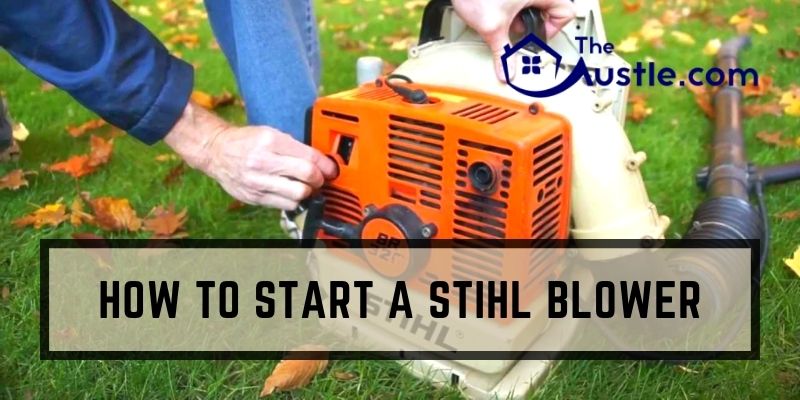Do you need to know how to start a Stihl blower? Everyone wants to save their energy and time. During work, people find a way that makes their work easily and quickly.
First, you need to know what the blower is. A blower is a piece of equipment that rotates the fan with force and sucks air from one side and throws it in the emitted environment at high flow or low pressure. They are mainly applied for ventilating, cooling, exhausting, conveying, etc.
Most of the people have a blower, but they don’t know how to start it. So, don’t worry. We are here to give you essential tips and advice, how to start a Stihl blower quickly?
Before buying any fan, you must check the airflow range, its pressure, and its engine forces. You need to know their types. Here, it is:
Types Of Blower
1.Single-Stage Blowers: This type of blower has-
- Air Flow rate: 40-1370
- Pressure: 0-460 MBR
- Motor forces: 0.2-18.5 kW
2.Double- Blowers: This type of blower has-
- Air Flow rate: 88-2050
- Pressure: 0-670 MBR
- Motor forces: 0.7-25 kW
Precaution Before Starting a Stihl Blower
Before starting your Stihl blower, you need to follow some essential precaution while using them:
- First, read the instruction manual for a complete guide.
- Use personal protective equipment such as facemask, sunglasses, gloves, boots, etc. when operating the Stihl blower.
- Before using, check the overall machine carefully for broken or damaged parts.
- Clean around the blower’s fuel tank cap with a clean towel to prevent dirt and other debris from entering the fuel system. Then, fill the fuel tank and make sure your lid is tied.
- Always start your gasoline power tool a minimum 10feet away from your fueling spot.
Guidelines For How to Start a Stihl Blower
A. For Hand Stihl Blower
- Before starting any blower, you should always securely place the blower level dust-free surface.
- Then, hold the fan in your right hand and, with the left side, firmly grip the starter rope handle.
- Pull the starter rope about 30-35cm again & again until the engine attempts to start.
- If the engine stops, leave the choke lever in the middle position and pull the starter rope back until it starts. It is the way to start a warm engine. If the motor is already warm, there is no need to close the choke.
- Push the start or stop switch into the STOP or OFF position for starting /ending the engine.
(Note: Start/stop status indicates I/O symbol where I=On & O=Off)
B. For Backpack Stihl Blower
- Firstly, set the backpack blower on flat ground. Then, using a dry scrub brush for cleaning the dust that can clog the air intake vents of the machine.
- Slide the stop button on the throttle handle up to the on position.
- Turn the setting lever, which is located just below the stop button, to the central or starting location. The throttle opens and closes at this level. The idle throttle position is the down position while the up position opens the throttle fully.
- If the engine is cold when starting, adjust the choke knob to the right to close the choke.
But if the driver is warm, turn it to the left or full choke. - Keep one foot against the side of the machine and one hand on top of the engine. Pull the starter rope until the driver attempts to fires. At first, pull the pull cord slowly, then pull quickly and hardly. If it needs multiple pulls, release the cable slowly to wind up correctly.
- When you start the cold engine, flip the choke position to the left to the open position quickly after the engine fires.
When you start the warm engine, no action is needed. - Turn the setting lever to the idle position. Allow the engine in this position for a few minutes to warm up the engine. Hold the throttle lightly to help the engine warm up.
- Put the blower on your back and hold the handle with the right hand. Turn the setting lever up to full throttle when operating.
We think the above guidelines help you how to start a Stihl blower quickly. So, follow the advice and tips while operating the machine to avoid an accident. Using a fan instead of a hand saves your time and energy. Let’s jump on it.
- Skid Steer Tractor Brush Cutter: Details & 7 Helpful Tips
- Mineral Oil for Axe Handle: Easy Deatils You Need To Know
- Skid Steer VS Tractor for bush hogging: Which 1 Is Best for You?
- How To Keep Pea Gravel In Place: Easy Learn For 7 Different Ways
- Best 5 Solutions – How To Get Rid Of Henbit And Chickweed
- How To Price Lawn Mowing Jobs – Best 5 Factors You Must Know!
- How to Clean River Rocks with Easy 7 Steps & Polish Them

